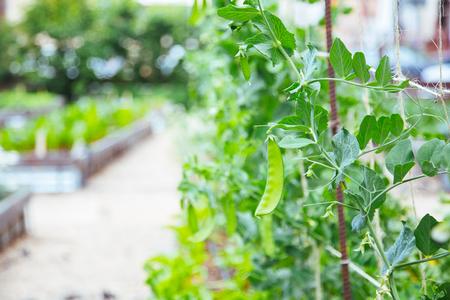Efficient use of space

Timing
Timing refers to the maximum use of the available growing season. Depending on the location in California, there are three to four seasons when vegetables can be grown. Yet many gardeners grow only summer crops. By planting a spring crop, a summer crop, and a fall crop, a gardener can get three crops from the same space. This requires close rotation of crops, such as spring lettuce followed by summer green beans followed by fall spinach. The idea is to plant a cool-season crop, follow it with a warm-season crop, then finish with another cool-season crop.
Trellising and staking
Do not grow horizontally what you can grow vertically. Twining and vining crops, such as tomato, squash, cucumber, and pole beans, use a great deal of space when allowed to grow along the ground. Trellises, stakes, or other supports minimize the ground space used and increase garden productivity. Support materials can be wooden structures, extra stakes, twine, wire cages, or a nearby wire fence.
Spacing
Improved varieties may be the best way for the space-conscious gardener to achieve higher yields. Today, a gardener can select bush varieties of beans, cucumbers, melons, and squash that require much less space than standard varieties. Determinate tomatoes (which grow only to a certain height) produce over a shorter time and can be trained more easily to a stake, whereas indeterminate types must be supported off the ground or trellised but will produce over a longer period. Several bush-type tomato varieties are suited to container culture on patios or other small spaces.
Succession planting is sowing seed of a given crop at 1 to 2 week intervals to produce a continuous supply of vegetables. Beans, turnips, and beets are well suited to this practice.
Companion planting is planting two crops in the same place at the same time. Normally one crop matures and is harvested before the other. Radishes and carrots work well this way, because the radishes can be harvested long before the carrots are very large. The quick-growing radish seedlings also help to mark planted rows.
Intercropping involves planting early-maturing crops between the rows of
late-maturing crops to increase production in a small area. For example, beans, radishes, green onions, spinach, or leaf lettuce may be planted between rows of tomatoes, peppers, cabbage, or corn. The quicker-maturing crops will be harvested before the others become very large.
Proper spacing between rows and within rows is extremely important. However, different spacing may be required in your garden.
The use of power equipment requires that the distance between rows exceed the width of the equipment. Maximum production requires wider than standard rows or beds for planting. For instance, seed of many crops, such as leaf lettuce or beets, can be broadcast in a bed 1 to 3 feet across and thinned to obtain proper spacing. Other crops, such as cabbage or broccoli, can be planted closely in wide rows so that their outer leaves touch one another when the plants are about three-fourths mature. These methods reduce space wasted as aisles and often provide such dense shade that weed growth is inhibited and evaporation of soil moisture is reduced.
Raised beds
Raised beds are often helpful in maximizing plant growing space in a garden. They provide the advantages noted above for wide beds, plus they improve drainage and can optimize soil otherwise poorly suited for vegetables. To raise beds, add large amounts of topsoil or organic soil amend-ments so that the bed is established above the previous soil level.
Use lumber or masonry materials to establish and maintain the perimeter of raised beds. Suitable resources include concrete block, stones, untreated cedar or redwood boards, non-arsenical pressure-treated lumber, and plastic composite lumber.
